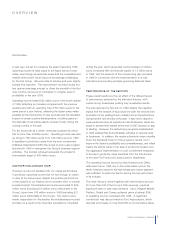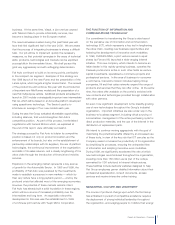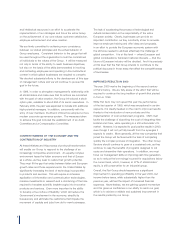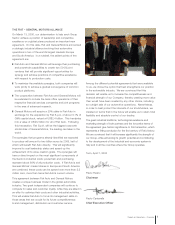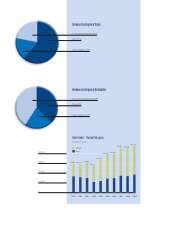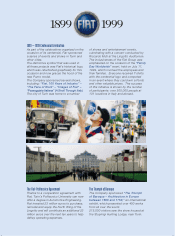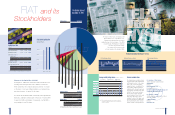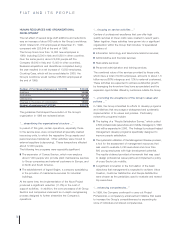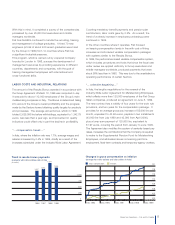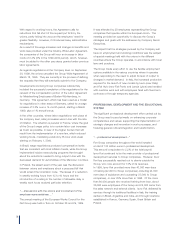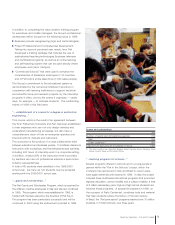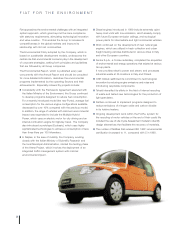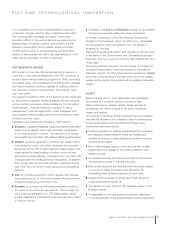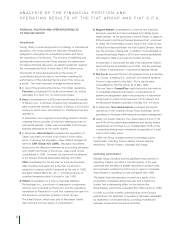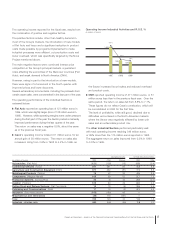Chrysler 1999 Annual Report Download - page 17
Download and view the complete annual report
Please find page 17 of the 1999 Chrysler annual report below. You can navigate through the pages in the report by either clicking on the pages listed below, or by using the keyword search tool below to find specific information within the annual report.
16
HUMAN RESOURCES AND ORGANIZATIONAL
DEVELOPMENT
The net effect of several large staff additions and reductions
was an increase of about 800 units in the Group’s workforce,
which totaled 221,319 employees at December 31, 1999,
compared with 220,549 at the end of 1998.
The Group hired more than 14,000 new employees in
1999, including 5,500 in Italy and 8,500 in other countries.
Over the same period, about 22,000 people left the
Company (9,000 in Italy and 13,000 in other countries).
Business acquisitions and divestitures completed during
the year resulted in a net increase of 13,500 employees.
Counting Case, which will be consolidated in 2000, the
Group’s workforce would number 236,500 employees at
the end of 1999.
Number of Fiat Group employees at 12/31/98 220,549
Additions 14,054
Reductions (21,784)
Outsourcing (5,000)
Changes in the scope of consolidation 13,500
Number of employees at 12/31/99 221,319
The guidelines that shaped the evolution of the Group’s
organization in 1999 are reviewed below:
“... streamlining the organizational structure ...”
In pursuit of this goal, certain operations, especially those
in the service area, were concentrated at specially created
insourcing units, to which the respective Group assets and
personnel were transferred. Other activities were moved to
external suppliers (outsourcing). These transactions affected
about 12,500 people.
The following two programs were especially significant:
❚The expansion of Comau Service, which now employs
about 7,000 people who provide plant maintenance services
to Group companies and external customers in Europe, and
in North and South America.
❚The establishment of Ingest-Segim, a company specializing
in the provision of maintenance services for industrial
buildings.
At the same time, the implementation of the Nova Project
produced a significant reduction (11.8%) in the cost of
support activities. In addition, the core processes of all Group
Sectors and companies underwent an in-depth reengineering
process designed to further streamline the Company’s
operations.
“... focusing on service activities ...”
Centers of professional excellence that can offer high
quality services at lower costs were created in recent years.
Taken together, these activities have grown into a significant
organization within the Group that includes 12 specialized
providers of:
❚Information technology and telecommunications services;
❚Administrative and financial services;
❚Real estate services;
❚Personnel administration and training services.
The combined value of the services provided by these units,
which have a total of 9,300 employees, amounts to about 1.5
billion euros (88% intragroup and 12% to external customers).
These activities are expected to achieve substantial growth
by leveraging the knowhow they have accumulated and the
expansion opportunities offered by customers outside the Group.
“... promoting the acceptance of the Group’s values and
policies ...”
In 1999, the Group intensified its efforts to develop programs
and initiatives that encourage a widespread and systematic
implementation of its values and policies. Particularly
noteworthy programs include:
❚The testing of a “People Satisfaction Survey,” which polled
2,800 professionals (executives and middle managers) in 1999
and will be expanded in 2000. The findings it produced helped
management develop programs specifically designed to
improve people satisfaction.
❚The systematic utilization of the Management Review process,
a tool for the assessment of management resources that
was used to evaluate 3,250 executives and more than
800 young employees with high development potential.
The results obtained provided a framework that was used
to design professional career paths and implement a policy
of cross-Sector job mobility.
❚A significant innovation in the formulation of the basic
objectives that management is expected to achieve: Value
Creation, Customer Satisfaction and People Satisfaction
were chosen as the yardsticks used to evaluate and reward
top executives.
“... enhancing competencies...”
In 1999, the Company continued to carry out Project
Professional, a competency enhancement initiative that seeks
to increase the Group’s competitiveness by expanding its
store of individual and shared competencies.
FIAT AND ITS PEOPLE


